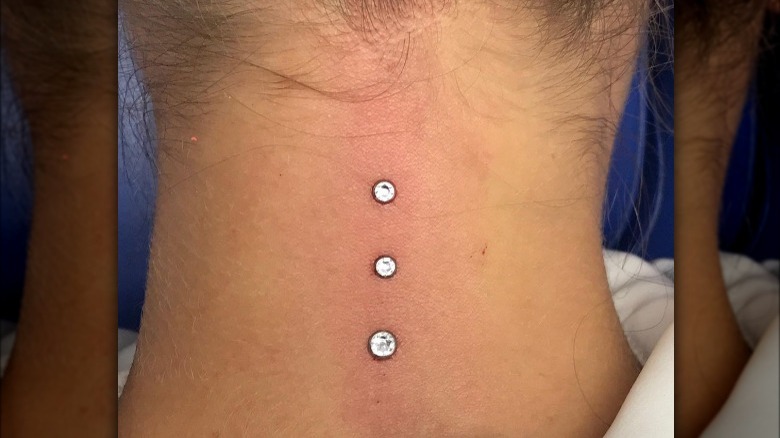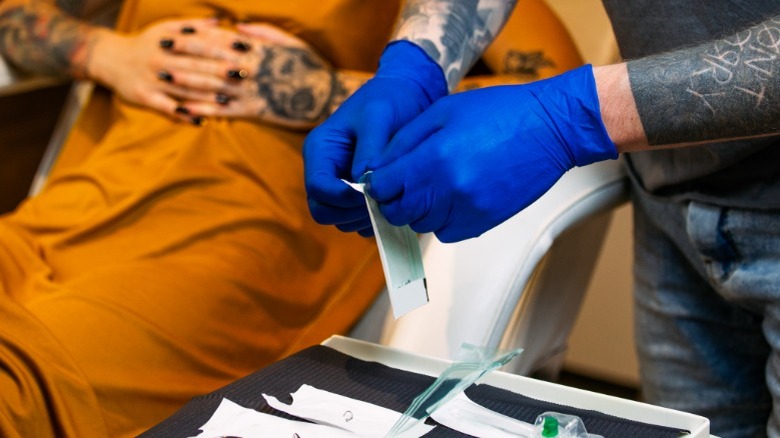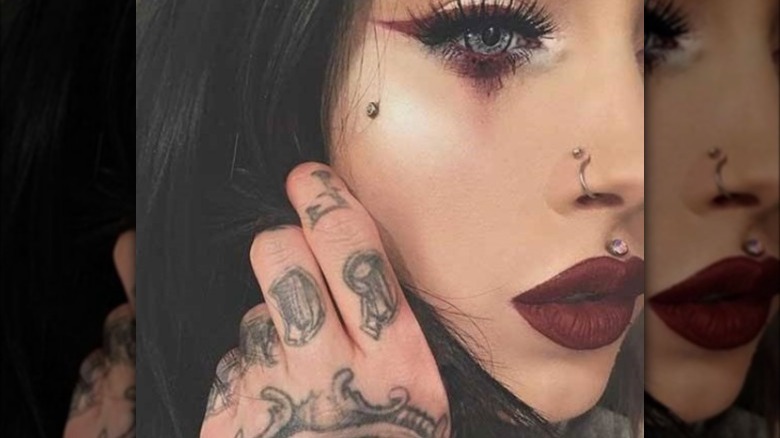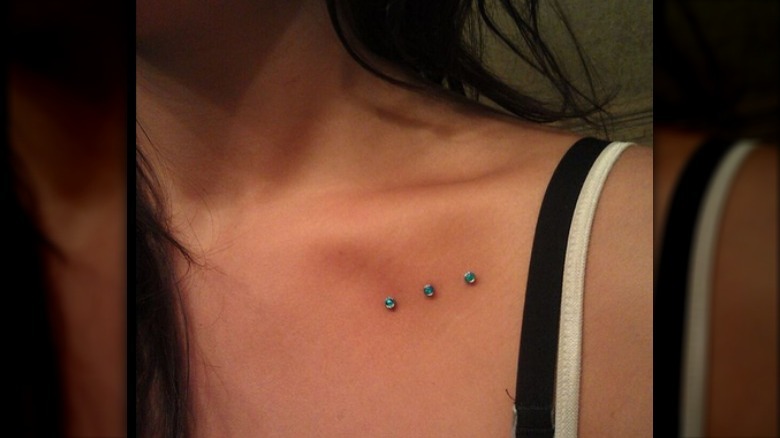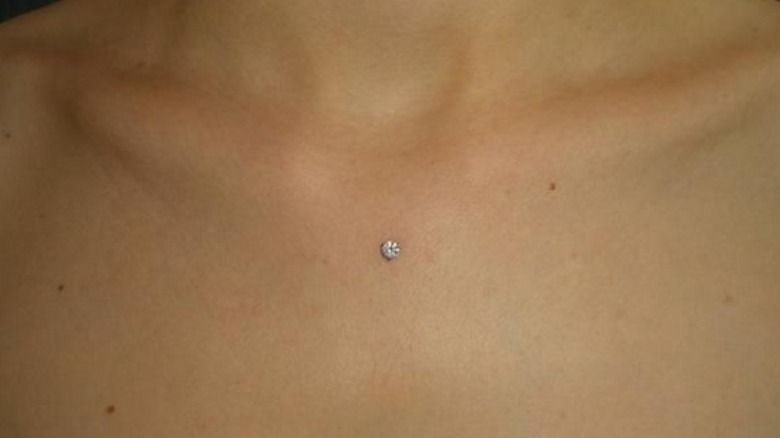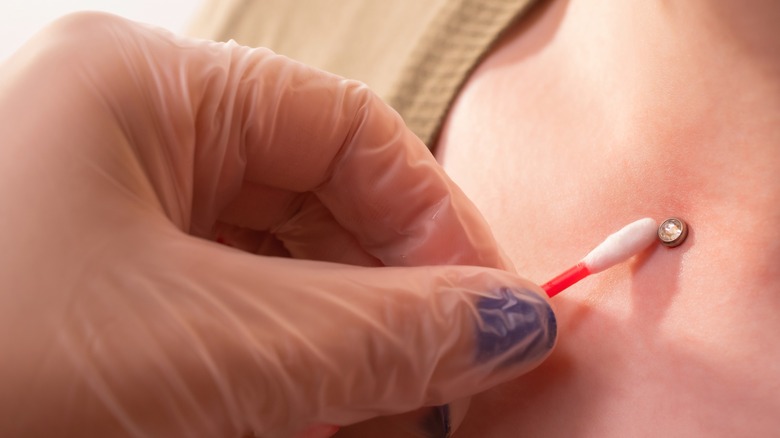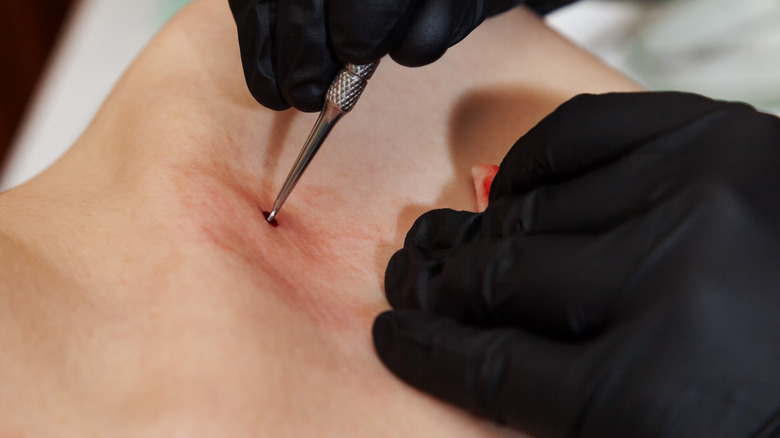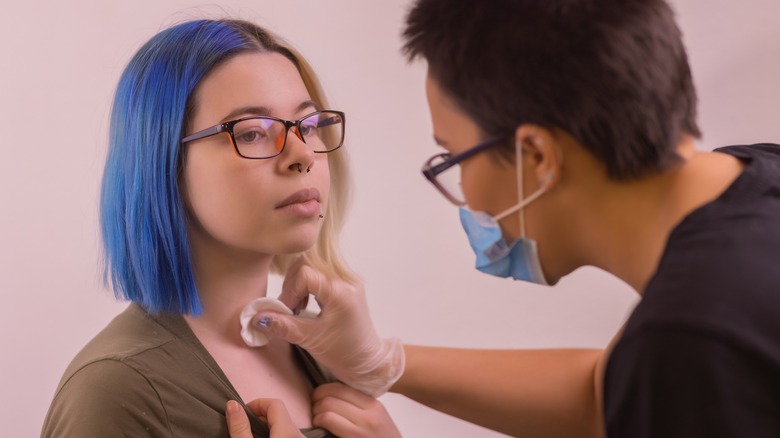Everything You Should Know Before Getting A Dermal Piercing
Human beings have been adorning their bodies with jewelry, tattoos, and piercings for thousands of years in civilizations across the globe. "I can safely say piercings are pre-historic and human remains suggest body modification goes back 25,000 years," notes anthropologist and piercing historian Paul King to Dazed. According to Vivid Ink, the earliest evidence of piercings was speculated to be a form of expressing a person's social identity and belonging, spiritual protection, and status.
Historically, piercings have been regulated to the head and face in various forms. In more recent years, people have become interested in piercing areas of the body other than the ears, face, and tongue. Dermal piercings, in particular, have risen in popularity, evolving from micro-piercings (via Mantra Tattoo).
Also known as dermal anchors, these dainty, surface-level piercings have been seen on a number of celebrities in the past decade, including Olympic gold medalist Simone Biles and rapper Cardi B. Like any piercing, tattoo, or body modification, dermal piercings are a serious commitment. Unlike more traditional piercings, dermals are not always suited for every person's lifestyle. They are unique and modern, but they can also be trickier to care for and have health and safety risks that are important to consider. A little research before you meet with your piercer can help you decide if a trendy dermal piercing is right for you.
What is a dermal piercing and where does it go?
Dermal piercings are ornamental piercings that sit on the surface of the skin. Also known as single-point piercings or surface anchors, this type of body art is different from a traditional piercing which involves creating a hole with an entry and exit point in the skin, such as with a nose or ear lobe piercing (via Healthline). Dermal piercings do not have a post with a removable back, but rather feature a gem that sits on the skin with a T-shaped anchor that sits below the skin's surface.
Dermal piercings can be placed on any flat surface of the body. "They can go in most places with little to no movement, such as the cheekbone or the back of the neck — basically places where you don't normally see your skin move," New York-based piercer Tom Gottschalk tells PopSugar. Many people choose to adorn their chest, forearms, lower back, and abdomen as well. Dermal piercings can be used as a substitute for actual jewelry like necklaces or bracelets and create a floating, minimalist effect. While there aren't any major limitations concerning placement, the skin has to contain a stable amount of fatty tissue to hold the dermal in place. Piercings on the collarbone, hands, fingers, and feet are typically discouraged by professional piercers as these areas are not only high-movement but have an increased risk of infection and permanent scarring.
How is a dermal piercing done?
Dermal piercings look lovely, but how does a piercer get the jewelry permanently inserted into the skin? "A dermal, also known as a surface anchor or microdermal, is a form of a single point surface piercing," professional body piercer Lynn Loheide tells Elite Daily. "They are pierced using a piercing needle to create a small pocket in the skin, and the base is inserted into this pocket. The base is about the size of a grain of rice, and the piercing process itself is often very easy."
A piercer will sterilize the skin and mark the area to be pierced with a marker. According to Healthline, once the skin has been punctured to create the L-shaped pocket, the piercer will use dermal forceps to insert the base of the jewelry into the skin. The gem part of the jewelry is screwed on top of the anchor and keeps the piercing in place. This type of piercing can be completed using a skin punch as well. With this method, instead of creating a pocket with a piercing needle, a tiny amount of skin tissue is removed with the skin punch before embedding the jewelry into the skin.
What type of jewelry is used for dermal piercings?
Dermal piercings require a different type of jewelry than traditional piercings. According to NYC Tattoo Shop, a dermal piercing has an anchor with either a rounded base or a flat foot that keeps the gem locked in place beneath the skin. Both types of anchors are used interchangeably, but many piercers prefer the flat-footed anchor because it is less prone to coming loose. Each type of anchor comes with a screw-on dermal top, which is the removable decorative element above the skin. Divers are a less common style of dermal jewelry that contains a base with a pointed end and a permanent top. They are less popular because, once inserted, they cannot be removed or changed.
Salamander Jewelry recommends choosing a dermal piercing carefully based on the area of the body you want to pierce, your lifestyle, skin sensitivity, and activity level. Since these jewelry items are 3D elements they can easily snag on clothing and are constantly exposed to the elements. Choosing a piece that is too big or bulky may cause unpleasant problems, so something that is flatter is always better. It is also recommended that you select an appropriate metal, such as surgical titanium or stainless steel, as these are less likely to cause irritation or corrode. Nickel and other low-grade metals are generally not recommended because, although they are cheap, they can cause allergic reactions such as an itchy rash or dark skin splotches (via Cleveland Clinic).
Dermal piercings are moderately painful
No piercing or body modification comes without a little bit of pain. After all, in the case of a dermal piercing, you are purposefully puncturing the surface of your skin with a needle. However, some piercings hurt worse than others depending on the area being pierced and the type of jewelry being inserted. Dermals are no exception to this. Most people who get dermal piercings report a moderate amount of discomfort which is described as pressure on the skin (via NYC Tattoo Shop). Areas with thinner skin and more cartilage, such as the clavicle or the fingers, are likely to be more painful as well.
According to Fresh Trends Fine Body Jewelry, the pain level of a dermal piercing is largely dependent on your individual pain tolerance and the experience of the person piercing you. A professional piercer is knowledgeable about the correct way to perform the procedure. They understand skin thickness as well as how close the piercing you want is to veins and nerves that can increase the level of pain you might feel both during and after the piercing. Depending on the state you live in, whether the piercer can use a skin punch or a traditional needle will also affect the painfulness of the piercing. Skin punches are preferred by many piercers for their quickness and the reduction in pain their clients report feeling.
Will dermal piercings leave a scar?
Dermal piercings also vary from traditional piercings in that they are not considered permanent fixtures on the body. "Surface piercings, including dermals, are all considered long-term temporary, meaning they should not be expected to last a lifetime," Loheide explains to Elite Daily. "Some folks get lucky and have these longer, and that's always the hope! But it shouldn't be the expectation."
A successful dermal piercing can last anywhere from a couple of months to seven years depending on placement and how well it is taken care of. When they are removed, via a medical professional, an experienced piercer, or via rejection, it is likely you will be left with a small scar. According to Grazia, whether or not a person scars after a dermal piercing removal is entirely dependent on the individual and their skin sensitivity. Some people are more prone to scarring than others.
Generally, dermal piercing scars are small, hypertrophic scars that are relatively flat and blend in well with your complexion. These types of scars can be shrunk down to a certain point with the help of certain oils or over-the-counter scar creams. If you know your skin scars easily, or you have a family history of keloids, you can expect a more visible scar after the removal of a dermal piercing.
How expensive is a dermal piercing?
The unique versatility of dermal jewelry combined with their moderately invasive piercing procedure means they can vary in cost. According to Essie Button, other factors that may influence the cost of a dermal piercing include the location you want to be pierced and the type of metal used.
Generally, a dermal piercing will cost between $70 to $100, which is slightly more expensive than an average ear piercing (via Supermoney). This variation in price largely depends on the quality of the shop you choose and the experience of your piercer. A mall kiosk that offers inexpensive metal jewelry is going to be cheaper than a professional shop with a license, experienced artists, and good hygienic practices.
It is also important to confirm that the price of your dermal piercing includes the jewelry. If it doesn't, you should tack on an additional $10 to $100 for the actual piece of jewelry, depending on the type of metal and design you want (via Greatist). It is considered appropriate to tip your piercer as well, which can increase the entire cost of the piercing by 20% or higher if you are happy with their work.
Dermal piercings take several months to heal
On average, dermal piercings take between two to three months to heal completely (via Urban Body Jewelry). According to Radiance by WebMD, this is roughly the same amount of time as a traditional ear or nose piercing, but considerably less time than a cartilage or inner-ear piercing, both of which can take a full year to heal.
Like any piercing, the amount of time it takes a dermal piercing to heal is directly related to how diligent you are with the aftercare process. You should also avoid touching the dermal piercing or playing with the jewelry. This will keep out errant bacteria and germs that can lead to infection and, ultimately, rejection. It will also allow the skin to affix properly around the T-shaped anchor under the skin, keeping it in place.
How the piercing is installed can also be a factor in total healing time. If a dermal piercing is installed too deeply it can cause the skin to pull together, leading to infection and tissue damage. If it is installed too close to the surface of the skin and can move around, it will make it harder for the body to heal around it, leading to tissue damage as well. Using a professional, experienced artist is key to avoiding these pitfalls, per Pierced.
How to care for a dermal piercing
Once you've gotten through the actual piercing and installation of a dermal piercing, you have to take care of it properly. Immediately after receiving a dermal piercing, your piercer will cover it with a clean bandage. The piercing should be kept covered for at least a week. According to Glaminati, the pierced area should then be cleaned at least twice a day with clean, dry hands. Apply a simple saline solution to the piercing and pat it dry with a fresh paper towel. NYC Tattoo Shop notes that you should avoid getting the pierced area wet for as long as possible, which means keeping it covered when you're in the shower for several weeks afterward.
Good hygiene practices aren't the only things you need to keep in mind when caring for a dermal piercing. It is important to also wear loose-fitting, breathable clothing to avoid putting pressure on the piercing or snagging the jewelry as it heals (via Greatist). It is also necessary to wash your bed sheets and towels frequently and avoid playing any sports that may interfere with the newly placed piercing. If you notice any crust or scabbing forming around the piercing, leave it be. This crusting is a normal part of the healing process and should ease up in the first couple of weeks. When the piercing can safely be uncovered, you can gently wipe the crust away with a clean, damp paper towel during your daily cleaning.
What happens if it falls out or gets infected?
It is not uncommon for dermal piercings to become infected or for your body to reject them altogether due to their unique placement on the body. "Any time a foreign body, such as a piercing, is introduced into the skin, there will be inflammation," Angelo Landriscina, MD tells Health. "In the case of piercing rejection, that inflammation actually starts to move the piercing toward the skin surface and can even cause it to perforate out of the skin." The body is accustomed to treating piercings like a foreign body and will work to push them out, similar to what happens when you get a splinter. Because dermal piercings are located so close to the surface layer of the skin, it is easier for the body to push them out making them prone to rejection (via Medical News Today). If a dermal becomes infected and pushes itself out completely, it is likely you will have a larger scar than if you have it removed professionally.
PainfulPleasures explains that an infection at the area of your dermal piercing can look like red, swollen skin that is warm to the touch. It may also have white, yellow, green, or brown-colored fluid draining from the piercing and be accompanied by fever or a rapid heart rate. If you suspect you have an infection, it is vital you seek out the advice of a medical professional as antibiotics may be necessary.
Can you have a dermal piercing removed?
So you have had a dermal piercing for a couple of months and you decide that you hate it. Maybe you can't stop bumping it against things or you hate the way it feels under your clothes and you just want it gone. The good news is you can remove it, but not by yourself. But it isn't necessarily a pain-free procedure.
According to the Piercing Hand Book, both doctors and professional piercers can remove a dermal piercing by cutting it free. However, unlike a professional piercer, a doctor is generally going to be untrained in how to remove a dermal piercing to achieve the smallest scar possible. On the other hand, a professional piercer is not allowed to numb the area before removal. If you want a dermal piercing removed, you will need to decide whether you want a painless procedure or a smaller scar. Dr. Piercing Aftercare notes that the anchor normally extends 4mm beneath the skin, away from the decorative top. While this would not leave a gigantic scar, it is significant, particularly if your piercing is on your face.
If you want to change the top of your dermal piercing instead of removing the entire piece, it is recommended that you go to a professional and have them make the switch. Although the tops screw on and off, touching the area with your bare hands can quickly lead to infection even if your piercing is no longer new.
Are dermal piercings safe?
Any type of piercing comes with risk. According to the Huff Post, complications from piercings occur between 17% to 35% of the time. These complications are often the result of inexperienced piercers, poor-quality materials, and a lack of proper routine care after the piercing has been installed. Infection, tissue damage, pain, and allergic reactions are common and can significantly slow down the healing process.
In general, trendy dermal piercings are considered to be a safe form of body modification or aesthetic adornment. Although they are prone to both migration and rejection due to their shallow placement in the skin, making mindful and well-researched choices about your piercer and the area you want to be pierced can make a huge difference in the viability of your dermal piercing (via Tat Ring). Professional piercer Adrian Castillo agrees with this point, telling Teen Vogue, "Most viral [piercing] trends don't go into detail about the healing process, the discomfort, and the possible long-term effects of doing these things to your body. I always tell people to listen to their piercer: A real professional will definitely let you know the cons of any body modification."

